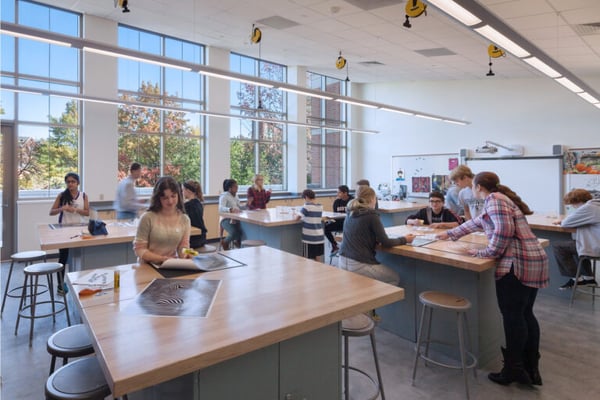What Are Post-Occupancy Evaluations and What Can You Expect?

Post-occupancy evaluations are a vital part of the architectural process. They help you and your architect assess how the project is serving occupants and provide an opportunity to revisit project goals.
At Neumann Monson, we believe in embracing feedback to improve our level of service and the quality of our work. Post-occupancy evaluations are just one of the ways we solicit feedback throughout the design and construction process.
To explain the benefits of an evaluation, this article will explore:
- The purpose of post-occupancy evaluations
- The typical evaluation process
- The impact evaluations have on building owners
After reading, you will know what to expect from a post-occupancy evaluation and how this process can help you and your team get the most out of your new space.
What is a Post-Occupancy Evaluation?
There are many ways to measure the success of a building project. A post-occupancy evaluation is an opportunity to solicit feedback from the building’s occupants, including those who work or maintain the space. The goal is to fully understand how the building is working for those who use the space daily.
Depending on the project, your architect may evaluate a variety of metrics, including:
- Thermal comfort
- Light levels
- Workspace comfort/ergonomics
- Acoustics
- Energy performance
- HVAC performance
Often, you can compare your post-occupancy evaluation results to pre-design survey feedback. Before you start the design process, your team may complete a survey to help you identify specific, measurable goals.
Perhaps your team would like to minimize distractions and increase productivity. Perhaps they would like to be more collaborative. Or perhaps they would like to improve their health and wellness through on-site amenities.
A post-occupancy evaluation assesses if and how well the design met these goals. For a building owner, the evaluation provides a tangible way to quantify the return on your investment.

Post-occupancy evaluations can test a variety of metrics, including light levels.
What Should You Expect from an Evaluation?
Typically, post-occupancy evaluations occur six months to a year after construction completes. By this point, you have settled into the new space and the excitement of a new environment has worn off, providing a more realistic read of the occupants’ experience.
Your architect will create a survey with your input, and you can add questions that address any concerns you may have with the building. For example, some building owners may want to know how often occupants utilize on-site amenities like showers or fitness facilities.
After you’ve collaborated with your architect, occupants will receive a survey with questions related to their comfort and use of spaces. The architect may request demographic information for more detailed and nuanced results. Demographic categories could include age, gender, the occupant’s position within your organization, years with your organization, and the area where the occupant spends most of their time.
Your architect can even visit the site and interview occupants if you prefer.
After the survey, your architect will compile data, create a list of action items (if applicable), and share their findings with you. Through this process, you can better understand occupants’ experiences and help them get the most out of the space.
How Do You Benefit?
After a post-occupancy evaluation, your architect may suggest ways to improve building performance and occupant wellbeing.
Some solutions may be low-cost. For example, your architect may suggest a different layout if occupants are underutilizing an area of the workplace.
Other solutions may require a slightly higher investment. Thermal comfort problems are one of the most common findings in post-occupancy evaluations. If you’ve ever worked in an office, you know it can be difficult (if not impossible) to find a temperature that satisfies everyone.
Low satisfaction rates, however, point to a larger problem with the HVAC system. If most occupants are too hot or cold, your architect may suggest operational changes.
For example, we recently conducted a post-occupancy survey for a commercial building and found that most occupants were cold in the morning. After sharing this finding, the building owner determined they could resolve the problem by reprogramming the HVAC to start before anyone arrived to work.
A post-occupancy evaluation brings issues to your attention and allows you to determine the best course of action.
Want to Learn More?
Post-occupancy evaluations are an important component of a successful building project. They assess occupants’ experience and allow you to reexplore project goals and assess the return on your investment.
The insights you gain from an evaluation can help you find solutions that improve comfort and efficiency—helping you get the most out of your new space.
To learn how else you can improve comfort and efficiency, read our guide to no-cost sustainability strategies.